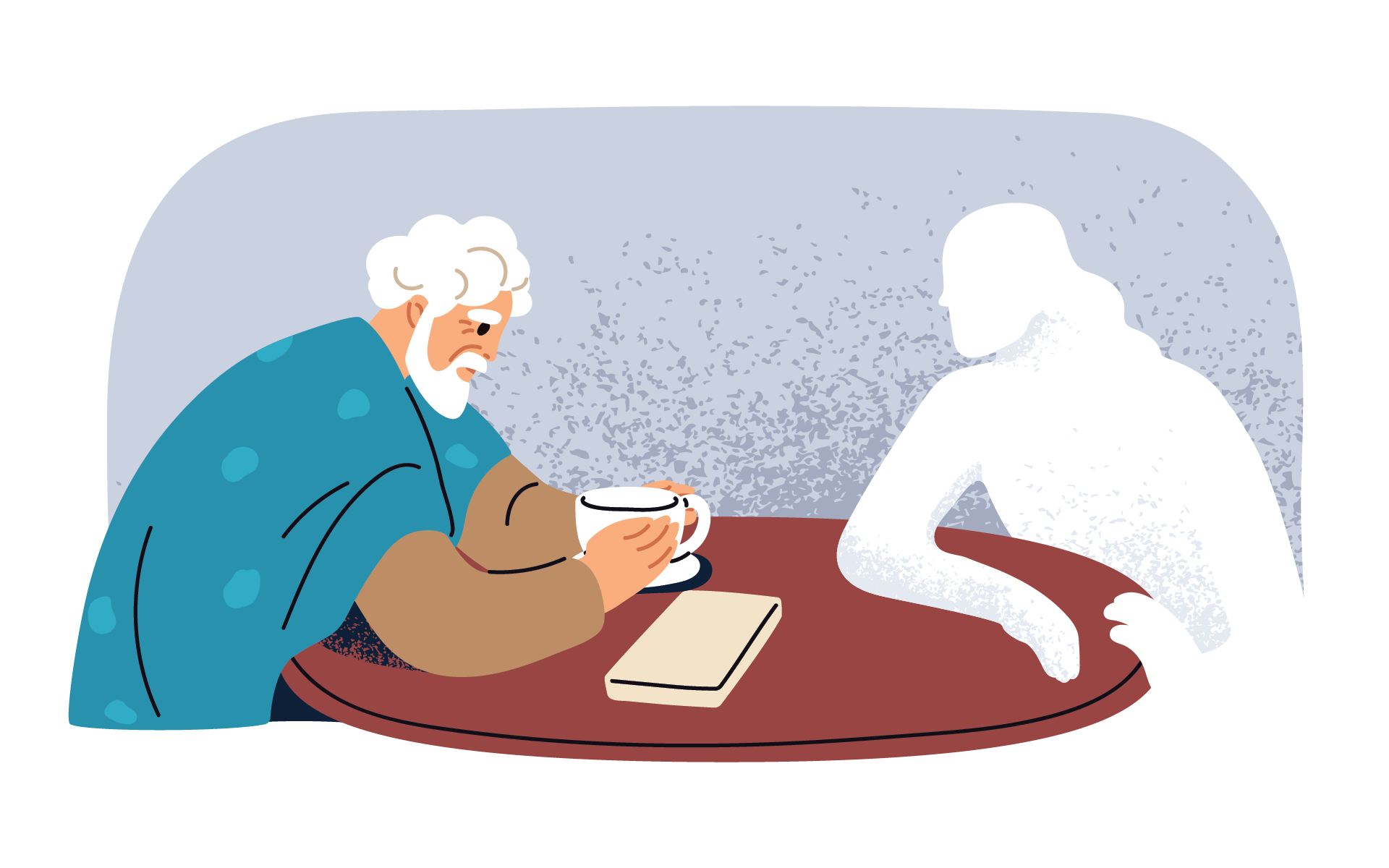If you’re experiencing what feels like a storm of painful, unnerving, or overwhelming emotions these days, you’re not alone. Each of us, no matter where we are, is navigating the landscape of challenges that face our world right now—from personal losses, to conflicts within families and communities, to the devastation of wars and the climate emergency. It’s completely understandable to feel unprepared for all that we face.
With a little practice, we can soothe ourselves and maybe even find the wisdom in our emotional roller-coaster.
But the truth is, while the circumstances we’re in may seem unprecedented, the difficult emotions we’re feeling are part of our inheritance as human beings. We don’t have to ignore or push away what we’re feeling. With a little practice, we can soothe ourselves and maybe even find the wisdom in our emotional roller-coaster. The ability to be with and befriend our emotions is our foundation for finding the good, and for responding to the crises around us with skill and compassion.
In honor of World Mental Health Day, here are five guided meditation practices, shared by world-renowned mindfulness teachers, that you can explore to help you turn toward your emotions, fostering insight, curiosity, and self-compassion.
World Mental Health Day: 5 Guided Meditations to Help You When The World Feels Heavy
1) Tune In to What Your Body Needs
This short self-regulation practice, known as H.A.L.T., allows us to check in with a few of our basic needs and emotional state. In a nutshell, H beacons for asking ourselves: Am I hungry right now? A means checking in to see: Am I angry or anxious, or otherwise dysregulated and activated? L stands for lonely: Am I feeling lonely in this moment? And T stands for: Am I tired?
Chris Willard guides this audio practice, encouraging us to deeply tune in to our body and discern what it may be telling us.
A 7-Minute H.A.L.T. Practice for Tuning In to Your Body
A 7-Minute H.A.L.T. Practice for Tuning In to Your Body With Christopher Willard
- Find a comfortable posture. If it works for you, you can simply allow your eyes to close, or leave them open and gently gaze downward.
- H: Check in with your body for any signals related to hunger. Are you hungry in this moment? How do you know? Do you feel it in your belly? Do you feel your energy down? Do you feel that “hangry” grumpiness coming on that some of us are familiar with? Just checking in with what your body and mind might be telling you about hunger. Your brain really needs a lot of fuel, a lot of energy, especially for impulse control and emotion regulation. So giving yourself the nutrition and calories that you need physically in terms of sustenance, it’s going to help you make good decisions and more effectively regulate those emotions. If there is some bit of craving, see if you can respond rather than react to it. Maybe you can plan a healthy meal that will satisfy you both physically and emotionally.
- A: Are you activated with the A of either anger or anxiety? These can be related to our fight-or-flight responses. When we’re in anger or anxiety or more primitive parts of our brain and nervous system, when we’re activated, we can’t regulate our emotions quite so effectively. We can’t think and reason things through considering the long-term consequences of our actions. How does your body tell you that you’re angry or anxious? Where in your body and your mind are you aware of it? And then making a choice for regulating and calming your body. Perhaps taking a few breaths, extending that exhale out. Perhaps grounding yourself by pressing your feet into the ground or taking a look around you. See the shapes and colors in the room. You might tense and release your muscles—whatever helps settle your nervous system, so it’s a little bit less activated and on guard.
- L: Are you feeling a sense of loneliness, that need for connection? Healthy regulation for so many humans actually starts with co-regulation with others. Our collective nervous system can ramp us up or can settle us back down. Interacting with others is almost like medicine that we need sometimes. And we know that social contact starts to build better regulation skills, boost happiness, regulate our mood, and help us take more effective perspective on the situations that are challenging us at any given moment. Checking in: Are you feeling lonely or are you feeling connected? And if there is some loneliness or longing, what simple action can you do? Can you reach out, text a friend, recall a moment of recent connection with others, or find some other way to contact someone supportive?
- And lastly, T. Are you tired? Again, our brains don’t function all that well when we’re tired, whether it’s because we didn’t get sleep or whether it’s we’re overworking and we’ve reached the end of a long, busy, frustrating day. Our ability to regulate our attention, even our willpower, starts to slip away. We lose cognitive capacity. We all feel not-so-sharp when we’re tired. Maybe right now is not the moment to take a nap, but can you give yourself perhaps a bit of rest? Can you find a way to put into your schedule in the coming hours or days a bit more time to yourself to rest and recharge? Or you might find a way to give yourself a little bit more sleep at night.
When you find yourself a bit dysregulated or overwhelmed, a few of these simple interventions can help. By asking ourselves, Am I hungry, angry, anxious or otherwise activated? Am I lonely, can I reach out? Am I tired, can I give myself some rest or a break? Do something restorative for my energy?, we can much more effectively manage whatever difficulties may arise over the course of a challenging day and weeks ahead.
2) Stay Present with Difficult Emotions
When we’re caught in the throes of an emotion like sadness, loneliness, or anger, shifting our awareness into our body allows us to experience the ever-changing nature of these strong and often unpleasant emotions.
Sharon Salzberg guides this practice to help you get used to the feeling of paying attention to difficult emotions in the body with curiosity and without judgment.
A 15-Minute Meditation for Cultivating Awareness of Difficult Emotions
A 15-Minute Meditation for Cultivating Awareness of Difficult Emotions With Sharon Salzberg
- Sit comfortably with your eyes either closed or slightly open, however you feel most at ease. You can begin this practice by bringing to mind a difficult or troubling thought or situation. Something that carries view an intense emotion such as sadness, fear, shame or anger.
- See where you feel this emotion in your body. What does it feel like? Where do you feel sensations arising? How are these sensations changing?
- See if you can you experience the sensations fully in the present moment. Can you experience them without getting hijacked by them—without immediately or anxiously working to make them go away? If you see those kinds of reactions in your mind, settle back. Come back into your body. Feel the different sensations being born of that emotion in this moment.
- Let go of any reactions or judgments. If you find you’re adding judgment, condemnation, future projection, practice letting go of those reactions as best you can. Almost as though they were birds now flying out of your hands into the air. Let them go, and return to the sensations of the emotion.
- Shift your attention to fully feel the sensation. Bring your focus of awareness to the part of the body where those sensations are the strongest. Once your attention is moved to the bodily sensations, perhaps say to yourself, “It’s okay, whatever it is, it’s okay. I can feel this without pushing it away or getting caught up in it.”
- Stay with this awareness of the bodily sensations. Notice your relationship to them. You’re just coming to accept them, letting them be. Softening and opening to them.
- Often the emotion is not just one thing. Maybe moments of sadness, moments of fear, moments of frustration, moments of helplessness. We just watch them arise and pass away. None of these states is permanent, unchanging. They’re moving and shifting.
- Stay curious about your present experience. No matter what story or add-on arises, come back to your direct experience in the moment. What am I feeling right now? What does it feel like? What’s happening? What’s its nature? And when you feel ready, you can open your eyes or lift your gaze and end the session.
3) Allow Your Emotions by Opening Up to Them
By allowing ourselves to experience where tough emotions are present in the body, and opening up to them with love, we can cultivate a sense of peace and acceptance toward the imperfect nature of life. Kristin Neff shares this meditation with just three basic steps, designed to support you in moments when you’re navigating difficult or disturbing emotions.
Soften, Soothe, and Allow: A 16-Minute Self-Compassion Practice
Soften, Soothe, and Allow: A 16-Minute Self-Compassion Practice With Kristen Neff
- Be seated in a comfortable position, either on a chair or on a cushion. Make sure your back is upright yet relaxed, and that your head is relaxed as well, tilted slightly downward.
- Take a few deep breaths. Let out the tension that you’re experiencing right now. So in and out, three times. Let your breath return to normal, just noticing how your breath feels as it comes into and leaves your body. Notice where you feel the breath most strongly: Is it at your nostrils, your lungs, your abdomen?
- Think of the circumstance or situation that’s causing you a lot of emotional upset right now. It may be something you’re feeling about yourself, something you don’t like, or some mistake you’ve made. Or it could be just a situation that’s very difficult to deal with right now. Remind yourself of the details involved, and try not to get lost too much in a storyline, but just get in touch with what it is that’s troubling you and how you feel about it.
- Focusing your attention on the body, become aware of what emotions are attached to this painful circumstance. There’s probably more than one. So maybe just labeling them. Anger. Disappointment. Grief. Fear. What’s coming up for you right now?
- Choose the emotion that you feel most strongly. What’s the predominant difficult emotion associated with your circumstance? See if you can tell where you feel that emotion in your body. Is it a gripping in the throat, a heaviness behind the eyes? A clenching if your gut? See if you can notice what part of the body is physically manifesting the emotion most strongly.
- Describe these sensations to yourself. Tight. Hot. Tingling. Numb. Cold. Just describe it in your mind. Because this is by definition a painful emotion, we naturally want to resist it, to tighten up against it, to make it go away. But this just makes it all the more painful.
- Instead of resisting, Soften around the emotion. Be aware of the emotion in the body, and try to soften around it. See if you can relax a little bit of the feeling of tension or pressure. Just soften. If emotion is very intense, you may want to focus your awareness on the edges of the emotion. Just kind of soften around the boundaries or borders of the emotion. Imagine that you have maybe a pool of water that you’ve let down the side. It’s not so tightly contained, so the water can just kind of pour out naturally. Just softening around the sensation.
- Then, Soothe yourself gently. Recognize and validate how hard it is to be feeling this. Every single one of us constantly feels really difficult, painful emotions. And we need to be able to comfort ourselves for the pain of living this human life. So what I’d like you to do is take your hand, and just gently touch the place where you’re feeling the emotion. Let your touch be soft, caring. Maybe caress the spot a little bit. And as you gently touch that spot, try to soothe the difficult emotions. Tell yourself that you recognize how hard it is to feel this way. If it feels comfortable, you might even say something like, “Poor darling, I’m so sorry. It’s so hard for you right now.”.
- Next, Allow any feeling you may be experiencing. Remember that you are allowed to feel this. This is your natural reaction. You aren’t choosing to feel this; this is what’s happening. Just soothe and comfort yourself with the fact that this is hard right now, to be feeling this. Just allow the sensation of the emotion to be there. You’re safe right now at this moment.
- Notice if the sensation is changing at all. Is it moving or shifting or changing quality? For the next few minutes, if the same emotion is still very strong and predominant—or perhaps a new emotion is arising, that becomes more predominant—just continue locating the sensation in your body, softening around the edges of the sensation so there’s not so much tightness or constriction. Soothe yourself and your body, the difficulty of what you’re feeling right now, with lots of tender compassion.
- If your mind gets pulled away into thinking about the situation or circumstance, that’s okay. It’s only natural. Gently try to bring your awareness back to the actual sensations of the emotion in your body very tangibly. If any feelings of peace or comfort arise, see if you can be aware of and be with those emotions as well. And if it’s still very difficult, then stay with the pain with the three techniques of soften, soothe, and allow. If you feel your mind starting to drift or if you feel you’re starting to tune out again, just try to refresh in your mind the source of the pain and get in touch with the feelings in your body. Soften, soothe and allow.
- Now drop the focus on this particular emotion or sensation. Let your awareness fill your entire body, just feeling the entire pulsating, energetic sensation of your body, from head to toe. Just let your awareness rest in your physical presence.
- When you’re ready to end this practice, place your hand gently over your heart. Just get in touch with feelings of tenderness, kindness, concern, compassion for what you’re going through. Remember that we’re all imperfect, that life is imperfect. And that if we can open to that, we can be happy and peaceful, even in the face of suffering.
4) Investigate Your Emotions with Curiosity
Curiosity is a helpful tool for engaging with our embodied experience, including feelings of sadness, anxiety, or any other unpleasant emotion. Judson Brewer reminds us that curiosity helps us tap into our natural capacity for wonder and interest, putting us right in that sweet spot of openness and engagement, even with difficult emotions. From this state of mind, we’re more empowered to help ourselves break out of these old habit loops and build new habits of kindness and curiosity. Explore this simple 7-minute exercise to help you shift your attitude toward what you’re feeling.
An 8-Minute Practice for Investigating Difficult Emotions with Curiosity
An 8-Minute Practice for Investigating Difficult Emotions with Curiosity With Judson Brewer
- Find a quiet, comfortable place. You can be sitting, lying down or even standing up. You just need to be able to concentrate without being distracted.
- Recall a recent time when you experienced a difficult emotion. You might even be feeling it right now. It could be anxiety. It could be feeling down or sad. See if you can remember the scene, maybe even relive the experience, focusing on what you felt right at that time.
- Check in with your body. What sensations can you feel most strongly right now? Is it tightness, pressure, contraction? Restlessness or burning? Tension, clenching, or heat? Maybe a pit in your stomach or a buzzing or vibration? Simply feel it and get curious. What is most predominant right now?
- Notice where the sensation is in your body. Is it more on the right side or the left side? Is it more in the front, the middle, or the back of your body? Where do you feel it most strongly?
- Explore what else you can feel in your body right now. If the sensation is still there, see if you can get curious and notice what else is there as well. Are there other sensations you’re feeling? What happens when you get curious about those? Do they change? What happens when you really get curious about what they feel like?
- Simply follow this procedure over the next couple of minutes. See what’s most predominant in your experience. What are the sensations? Don’t try to do anything about them. Simply observe them. Do they change when you observe them? What happens when you bring a really solid attitude of curiosity?
- It’s often helpful to check in with your attitude, to see if you’re truly being curious or trying to be curious. I find it helpful to simply check to see if my mind is going hmm. What’s happening in my body right now? as compared to trying to force myself to be curious. So whether it’s out loud or just an inner hmm, you can check from time to time to see if your mind is truly being curious or if it’s trying to be curious or thinking too much.
- If you notice that you’re trying or you’re thinking, you can simply get curious about that. Hmm. There’s a thought. Hmm. What does trying feel like in my body? Just continue this noticing for the next couple of minutes. And as you practice, whatever the challenging emotion is, simply get curious. Where do I feel it? Do the sensations change over time? Where do I feel the most strongly in my body?
As we finish up, I hope this short exercise has helped you get a taste of curiosity as a way to support your natural capacity to be aware of what’s happening in your body right now. Even with challenging emotions, we can bring this attitude of kindness and curiosity to our experience, moment to moment. What do I feel? Where do I feel it? What does it feel like? Hmm. And each time, we’re naturally bringing in that curiosity.
If you’ve noticed that by being curious, you’ve gained even a microsecond of being aware of those thoughts, those emotions, those body sensations, and that you can actually be with these rather than running away from them, you’ve taken a huge step forward. Thank yourself for taking this time to take care of yourself, and notice what that feels like as well.
As you move into the rest of your day, see if you can bring some of this curiosity with you as you go. Each moment, maybe even just taking a moment to notice when you’re caught up in an emotion or when you’re resisting something. And maybe drop in a little hmm. What does this feel like? And see what happens next.
5) Be at Peace With Change
One of the most challenging parts of life is that it’s always changing, sometimes in unpleasant, unpredictable, and unplanned ways. When we’re going through a time of unwanted change—someone we love dies, or we have a breakup or a divorce, maybe an injury or an illness of ourselves or others, or we get fired from our job—then we struggle not only from the pain of this loss, but from the unexpected nature of it. Part of the reason for this upset is because so little is in our control.
Through accepting that everything is not up to us—as we stop trying to control what we can’t change, or trying to predict what we can’t predict—we can feel a lot more at ease and more open to the moment-to-moment unfolding of our lives.
In this practice, Kimberly Brown helps us reflect on the reality that everything is impermanent. It’s always changing, coming together and falling apart. And it’s frustrating to not be able to make things go our way. Through accepting that everything is not up to us—as we stop trying to control what we can’t change, or trying to predict what we can’t predict—we can feel a lot more at ease and more open to the moment-to-moment unfolding of our lives.
A 10-Minute Meditation to Help You Let Go and Be at Peace With Change
A 10-Minute Meditation to Help You Let Go and Be at Peace With Change
- First, find a place where you can just sit down and be still. Turn off your devices, close your eyes, and just take a few breaths. Noticing your feet, your seat, your belly. Bringing your attention to your forehead, your cheeks, your jaw, allowing sound to enter your ears, allowing taste to enter your mouth.
- Put your hand on your belly. Just notice how you feel your belly inflates as you inhale and how it contracts when you exhale.
- Call to mind someone you know who’s struggling right now. You could maybe imagine that they’re here with you, visualize them, or just have a sense of their presence. If you like, put your hand on your heart and silently offer them this phrase: May you be at peace with the changes in life. May you be at peace with the changes in life. May you be at peace with the changes in life. Continuing silently repeating this, as though you’re giving a gift to this struggling being.
- Notice: Where is your attention? If you’ve lost the connection with this struggling being, reconnect, begin again. May you be at peace with the changes in life.
- Let go of this connection with this other being. Noticing your feet, feeling your seat, relaxing your shoulder blades, bringing your attention to your breath, to the light entering through your eyelids.
- Next, put your hand on your heart and connect with yourself. You can imagine that you’re looking in the mirror, imagine yourself as a child, or just connect with your beautiful presence. Give yourself the same wisdom: May I be at peace with the changes in life. And continue here just for a minute or two, giving yourself this compassion and wisdom.
- Notice where your attention is. If you’ve lost your connection to yourself, and gently come back, reconnecting. May I be at peace with the changes in life. Just for one more minute, giving yourself this kindness. May I be at peace with the changes in life.
- Keep this connection with yourself, and now include that first being and perhaps everyone that you know and love. May we be at peace with the changes in life. May we be at peace with the changes in life.
- Expand the phrase to include all of the beings. All of the living creatures in this ecosystem we call Earth. All of us struggle with change, with loss, with impermanence. Giving your wisdom and your kindness and your good heart to all of us, including yourself. May we all be at peace with the changes in life. May everyone be at peace with the changes in life.
- When you’re ready, conclude your meditation. You can close your practice by thanking yourself for your good intention, for your beautiful heart, for these joyful efforts.
Remember that you can practice in this way whenever you need to. Stop, feel your feet, put your hand on your heart, and say to yourself, May I be at peace with the changes in life. If you’re struggling with an unexpected loss, be sure to be patient and kind with yourself, and check in with your good heart as often as possible.
read more
A Mindful Guide to Navigating Difficult Emotions
World-renowned meditation teachers and researchers describe why courageously turning toward and meeting difficult emotions with kind awareness and self-compassion is so transformational.
Read More
Free (Or Almost Free) Mindfulness Apps That Offer Mental Health Support
More people are turning to mindfulness apps to support their mental well-being—Here are a few that we think are worth trying.
Read More
A Mindfulness Practice to Meet Tough Emotions with Curiosity
Curiosity is a helpful tool for engaging with our embodied experience, including emotions like sadness, anxiety, or any other unpleasant emotion. Explore this simple exercise to help you shift your attitude toward what you’re feeling.
Read More










